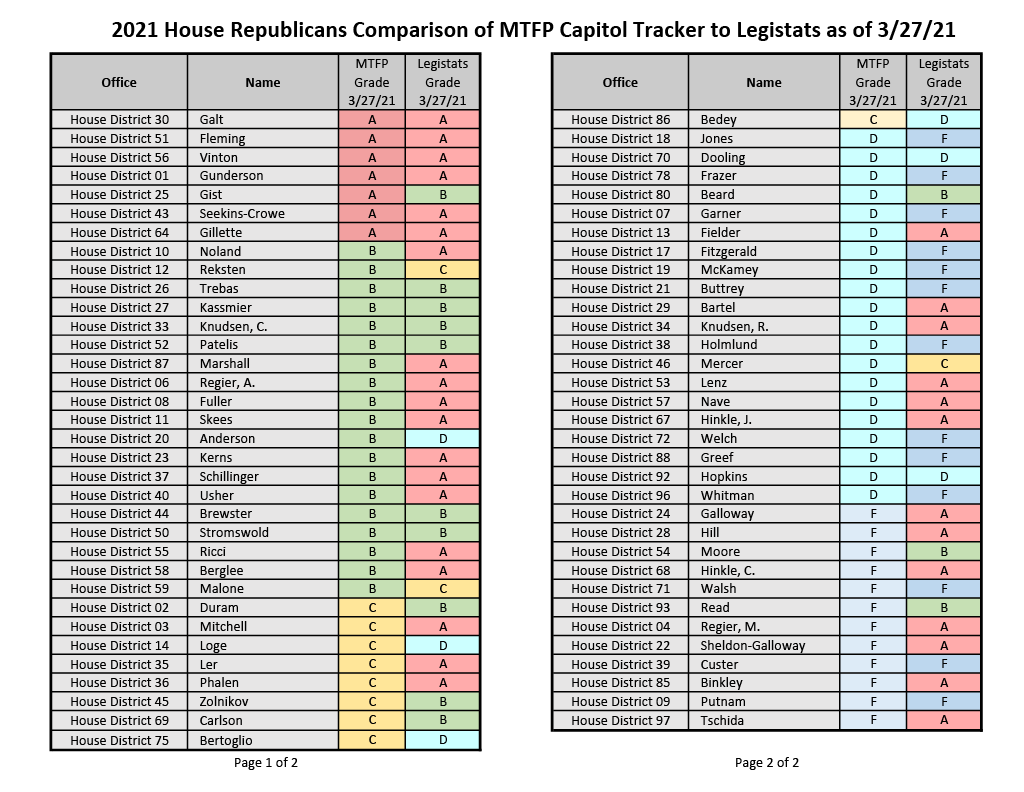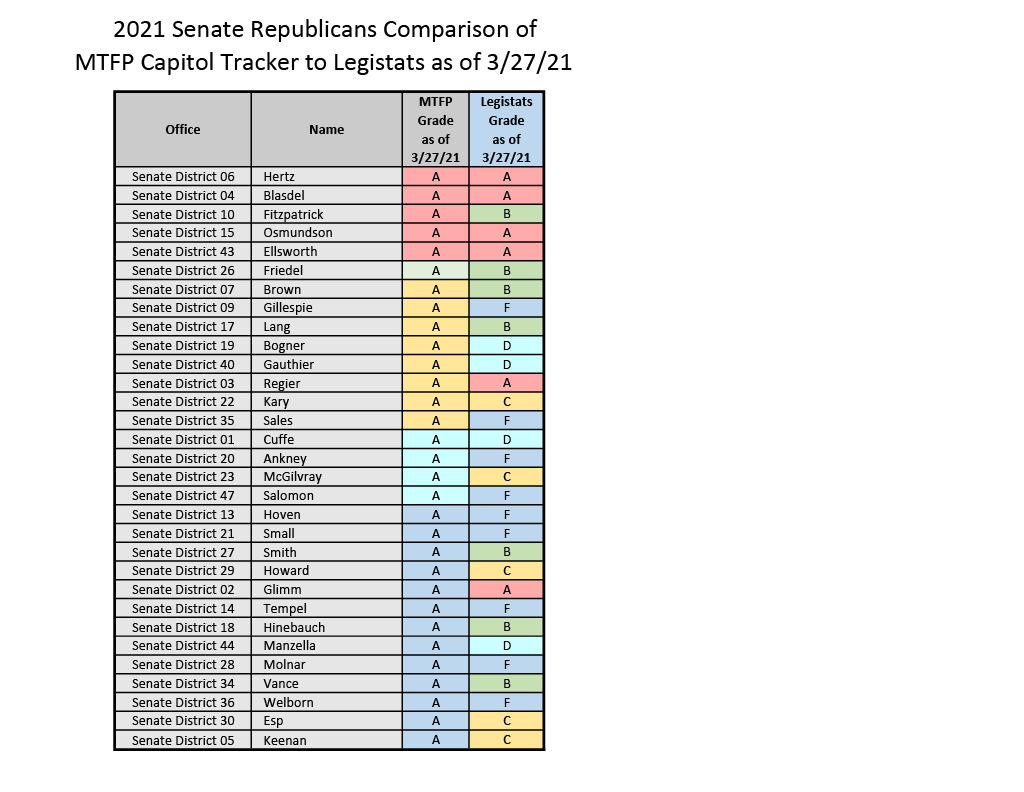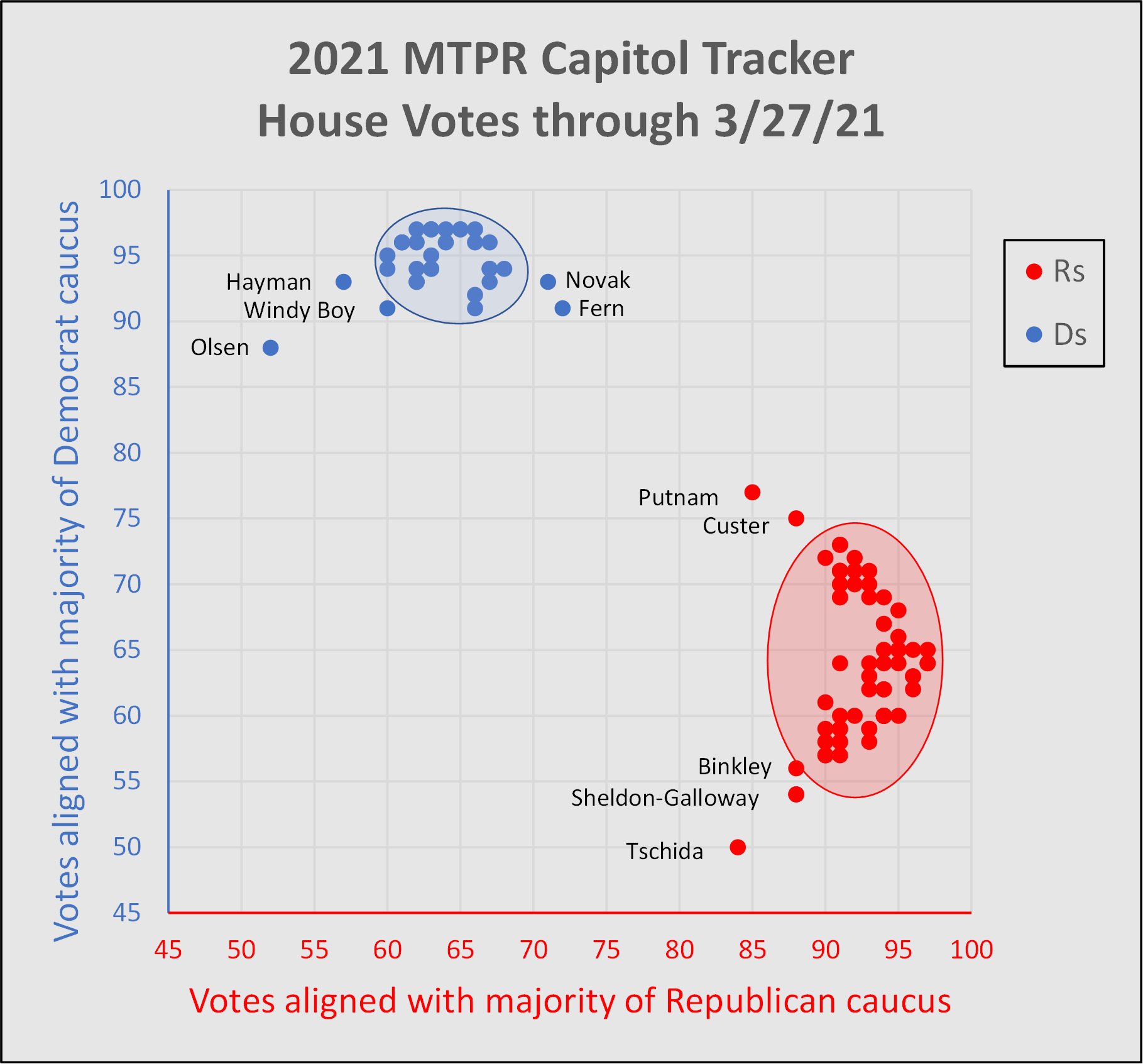The Danger of Loyalty Indexes
One scorecard technique frequently seen when discussing scorecards for legislators is the “loyalty index” or “loyalty scorecard”. The two most often used are Legistats, Inc. (which scores only Republicans) and Montana Free Press Capitol Tracker. Both Legistats and MTFP Capitol Tracker use similar mathematical indexing formulae to derive a percentage of “loyalty” for each legislator. Legistats assigns a letter grade using a common formula that can easily be applied to the Montana Free Press (MTFP) Capitol Tracker.
However, as is readily visible in the scorecard comparison charts below, when one compares “loyalty” grades from the two scorecards using the same time period, there is a wide disparity in the grades for many legislators. For example, many legislators graded “A” in legislator loyalty by Legistats are graded “F” by MTFP Capitol Tracker.
Note: the comparison charts below use 2021 data because MTFP has not updated the loyalty scores for 2023. If/when MTFP loyalty scores are updated, the charts below will also be updated. However, since these charts are strictly for illustrative purposes to demonstrate the built-in bias of a loyalty index such as Legistats, the charts below remain valid for that purpose.


WHY THE DIFFERENCE?
Legistats states that it scores only partisan floor votes, defined as partisan which they define as “over 50% of the votes FOR are from one party and over 50% of the votes AGAINST are from the other party. However, votes are not included if Republican legislators unanimously vote FOR or Against.
There is also a major difference in the number of votes actually considered in the scoring. Based on our comparison of both scorecards as of 3/9/21 (halfway point of the session based on the transmittal deadline), Legistats scored only about half the number of votes scored by MTFP Capitol Tracker.
Legistats’ limitation of scoring only “partisan votes” means that good conservative bills that support the Republican Platform and are overwhelmingly supported by Republicans are not included in the score. Likewise, bills that are anti-conservative or that defy the Republican Platform will be counted as “good votes” if supported by the majority of Republicans.
THE PROBLEM WITH “LOYALTY” SCORECARDS
The first question one must ask is “loyalty to what?” In the case of any automated loyalty scorecard, such as Legistats, that simply derives the number of times a legislator votes with a majority of legislators from their party, loyalty is determined on the fly with the majority to which a legislator displays their loyalty being determined only by the legislators voting FOR or AGAINST at that moment. The group of legislators to which loyalty is demanded at the time may be voting for an anti-conservative or anti-Republican bill but the loyalty score will define the bill as pro-Republican while the legislators voting against the bad bill will be called RINOs (Republican In Name Only).
The next question one must ask is what the A-F grades actually mean. Even in the case of Legistats which scores only partisan bills, the spread (difference between the highest score and the lowest score) is so small it renders the resulting grade insignificant when comparing Republican voting patterns to Democrat voting patterns.
Imagine a bad bill that defies many sound Republican principles. If enough Republicans vote FOR this bad bill, those Republicans with the courage, intelligence and true loyalty to the Republican platform will be penalized and labeled as RINOS by Legistats for voting against this bad bill.
So called “Loyalty” scorecards such as Legistats are made to look like objective indicators of loyalty yet are easily manipulated by legislators who care little for their party or their constituents, wanting instead to insure their reelection and increase their own power. The “Loyalty” scorecard can be manipulated and used as a tool to disparage any legislators who refuse to go along with the present power structure.
CONCLUSION
Legistats’ small sample, small spread between high and low vote scores, and “moving target” definition of party loyalty makes the Legistats scorecard less than useful in determining a legislator’s true loyalty to party ideology or principles. By its own admission, Legistats scores say nothing about whether a legislator is conservative or not as evidenced by this direct quote from its website: “This index does not reflect a legislators [sic] voting record based on specific issues in relationship to party platforms or their own social, constitutional or fiscal ideology.” Legistats, while perhaps initially well-intentioned, has become a tool used by manipulative legislators to control the votes and grow their own power at the expense of good governance and effective legislation.
MTFP Capitol Tracker presents a clearer picture of legislator loyalty to their party. All legislators and all bills are scored. A clear distinction is shown between Republican and Democrat voting patterns, as seen in the chart below. As with Legistats, however, the MTFP Capitol Tracker scorecard does not reflect a legislator’s voting record in adherence to their party’s platform or to any social, constitutional or fiscal ideology.
As the following charts clearly show, while there are certainly variations in the level of legislator loyalty within each party and a few outliers, the legislators within each party are not “crossing over” to vote with the opposite party in any high amount of frequency. Republicans and Democrats stick together and vote “loyally” to their party in the vast majority of votes.


